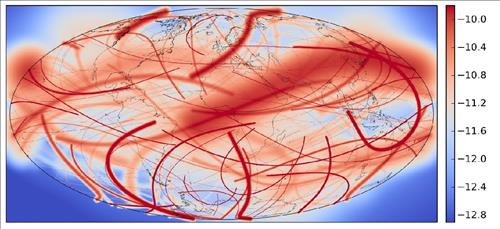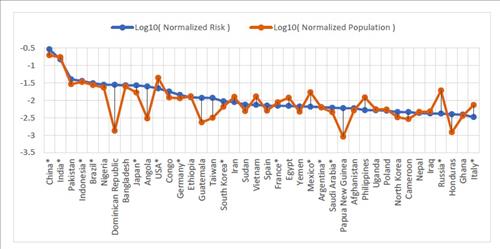지구의 소행성 충돌, 한국은 얼마나 가능성 있을까? Disaster planning against asteroid impact(VIDEO)
세계 206개국 중 17번째로 높아
2100년에
英 연구팀, 잠재적 충돌위험 소행성 261개 분석
국제 협력 필요성 제기
[관련기사]Related Article
Asteroid tsunami could kill thousands in Britain, warn scientists
edited by kcontents
케이콘텐츠 편집
우리나라가 2100년까지 발생할 가능성이 있는 지구와 소행성 충돌로 인해 피해를 볼 위험도가 전 세계 206개국 가운데 17번째로 높다는 연구 결과가 나왔다. 3일 영국 사우샘프터대학 피터 앳킨슨 교수와 클레멘스 럼프 연구원(박사과정)이 '세계 소행성을 날'(6월 30일)을 맞춰 내놓은 '세계 소행성 충돌 및 그 영향 분포' 보고서에 따르면 2100년까지 소행성 충돌로 피해를 볼 위험이 가장 큰 나라는 중국이며 한국은 17번째로 위험도가 큰 것으로 나타났다.
전세계 소행성 충돌 위험 지역 분포. 영국 사우샘프턴대학 연구진이 2100년까지 지구와 충돌할 확률이 높은 261개의 잠재적 충돌체(VI)의 궤도를 분석해 지역별 충돌 위험을 추정한 지도.�은 색이 짙을수록 소행성 충돌 위험이 큰 지역(Impact Corridor)을 뜻한다.
2100년까지 소행성 충돌로 피해를 당할 위험도가 높은 40개국. 영국 사우샘프탠대학 연구진은 지역별 소행성 충돌 위험과 그 지역의 인구밀도를 연계해 국가별 소행성 충돌 피해 위험도를 추산했다. 연구진은 지금까지 발견된 소행성 1만3천여개 중 2100년까지 지구와 충돌할 확률이 높은 '잠재적 충돌체'(Virtual Impactor) 261개를 자체 개발한 소행성 충돌 위험 프로그램(ARMOR)으로 분석, 세계 206개국의 소행성 충돌 피해 위험도를 계산했다. ARMOR은 소행성 궤도 소프트웨어(OrbFit)를 기본자료로 하고 태양과 행성들, 달의 중력 영향을 고려해 소행성이 지구와 충돌할 가능성을 예측하는 프로그램이다. 연구진이 분석한 잠재적 충돌체들은 지름은 30∼341m이다. 1908년 러시아 퉁구스카에 떨어져 산림 2천㎢를 파괴한 소행성은 크기가 30m 정도, 2013년 러시아 첼랴빈스크에 떨어져 1천500여명을 다치게 한 소행성은 지름이 19m 정도로 추정된다. 연구진은 261개의 잠재적 충돌체에 대해 각각 떨어질 확률이 높은 지역(Impact Corridor)을 계산해 충돌위험 지도를 만들고 이를 지역별 인구밀도와 연계해 국가별로 종합적인 소행성 충돌 피해 위험도를 추정했다. 그 결과 소행성 충돌로 피해를 볼 위험이 가장 큰 나라는 중국으로 나타났으며 인도, 파키스탄, 인도네시아, 브라질, 나이지리아, 도미니카공화국, 방글라데시, 일본, 앙골라 등이 뒤를 이었다. 한국은 17위였고 북한도 33번째로 소행성 충돌 피해 위험이 큰 나라로 꼽혔다. 미국은 플로리다와 루이지애나 등에 직접 소행성이 떨어질 가능성이 있는 것으로 예측됐지만 전체적인 위험도는 11위인 것으로 분석됐다. 도미니카공화국과 앙골라, 과테말라, 대만, 파푸아뉴기니, 온두라스 등은 인구밀도에 비해 소행성 충돌 피해 위험이 상대적으로 높은 것으로 나타났다. 연구진은 이 연구는 이미 알려진 소행성들이 2100년까지 지구와 충돌할 가능성을 분석한 것으로 세계 각국이 자연재해 대응 계획에 소행성 충돌 위험을 포함하고 일반인들에게도 그 위험을 알릴 필요가 있음을 시사한다고 밝혔다. 이들은 또 "이 결과는 소행성 위협에 대처하기 위해 국제적인 협력이 필요하고 특히 선진국들이 소행성을 발견하고 위험을 줄이는 데 앞장설 필요가 있음을 보여준다"고 강조했다. 이에 앞서 영국과 한국, 미국, 러시아 인도, 호주, 남아공 등 세계 33개국은 1908년 퉁구스카에 소행성이 떨어진 날을 기념해 지난달 30일을 제1회 소행성의 날(Asteroid Day)로 선포하고 앞으로 10년간 100만 개의 소행성을 발견하고 추적하기 위한 캠페인에 돌입했다. 국내에서도 한국천문연구원(원장 한인우)이 '소행성의 날 한국 웹사이트'(ad2015.kasi.re.kr)를 마련, 소행성 관련 자료 및 행사를 소개하고 있으며, 일반인들도 이 사이트에 이름과 이메일 주소 등을 입력해 캠페인에 참여할 수 있다. (대전=연합뉴스) 이주영 기자 scitech@yna.co.kr |
Disaster planning against asteroid impact

source killerasteroids.org
edited by kcontents
University of Southampton
PhD researcher Dr Clemens Rumpf has developed a software (named ARMOR) that can predict the impact locations of asteroids and their impact effects. Here he discusses Asteroid Day and how ARMOR can help disaster planning against asteroid impact.
Today (30 June) is Asteroid Day and this initiative aims to inform the public and raise awareness about the possibility that asteroids can collide with the Earth in the future.
The specific date was chosen because in 1908, on the same day, a 30-metre sized object entered the atmosphere over a forest region in Siberia and exploded in mid-air. The resulting shock wave and heat levelled the forest over an area larger than Greater London. In fact, about twice a year, an asteroid causes an explosion in the atmosphere that releases the energy equivalent to the Hiroshima bomb.
What’s more, everybody can see asteroid hits first hand when one looks up into the night sky and happens to see a shooting star that leaves its bright streak against the starry background. A shooting star is typically only a grain sized particle that burn up in the atmosphere but it is the same mechanism as a larger scale asteroid collision, only with less consequences. Asteroids are part of our natural environment and we have lived with them as long as we have existed.
Even though there is a regular influx of cosmic material onto the Earth, an asteroid impact only rarely causes damage. Usually, asteroids are too small, explode too high or enter the atmosphere over uninhabited territory, such as the oceans that cover 70 per cent of the Earth’s surface. However, in time intervals that can be measured in tens or even hundreds of years, an asteroid impact causes significant damage. A relatively small impact event occurred over the Russian city of Chelyabinsk in 2013. Here, a 17 metre-sized object caused a shock wave that shattered windows and glass shards injured about 1500 people. Impacting asteroids can measure hundreds of metres in diameter and have the potential to cause significant damage to our civilisation. Such an event may lie many years in the future but the potential damage that could be caused is reason enough to research asteroids and learn about their potential for natural disaster.
In contrast to other natural disasters, such as earthquakes, an asteroid impact is predictable. Shortly after an asteroid is discovered, its impact probability and its impact time can be calculated to hour level accuracy even if the potential impact is tens of years in the future. In addition, the impact location can be constraint to lie within a so called ‘impact corridor’ as shown in this image. Because of uncertainty in the observations of asteroids, the impact point prediction does not produce a point but a corridor that typically stretches across half the globe.
ARMOR
In order to make use of the favourable condition that an asteroid impact is predictable, the asteroid needs to be discovered before it impacts the Earth. Currently, we know of only about 1 per cent of the asteroids that can impact the Earth in the future. This means that the next asteroid impact will likely happen without warning, just like in Chelyabinsk. What is needed now are telescopes that help us discover all potentially threatening asteroids.
Space-based telescopes, such as the Sentinel mission proposed by the B612 Foundation or NASA’s proposed NeoCam mission, would be able to discover most of the remaining asteroids within 10 years. The observations of such telescopes would also help reduce uncertainty in the observational data. Less uncertainty means that we can make a clearer statement about whether or not an asteroid hits. Similarly, better observations collapse the impact corridor to smaller width and allow to make better predictions about where a potential impact might occur.
Considering the entire asteroid population and averaged over a long period of many years, any region on Earth has equal likelihood to be impacted by an asteroid. The average impact distribution can be likened to a pile of many transparent, sharp images stacked above each other. Stacked together, the sharp images produce a blurred picture with little distinguishable information. But taken by themselves, each individual image represents the day to day knowledge of where an asteroid impact is most likely to occur. One such snapshot image is shown here:
Asteroid impact probability
The current knowledge of the asteroid impact probability distribution changes over time because new observations improve our knowledge. But information, such as shown in the last figure, can help disaster planning because it is our current best guess of where an asteroid impact might occur. Usually, impact probabilities are low, similar to winning the jackpot in the lottery. This is the daily situation that we live in and not very worrisome. However, some asteroids stand out and in 2004 the asteroid Apophis had a 3 per cent probability to impact in the year 2029. In such a scenario, it is important to know where the impact can occur and what the consequences might be.
To support decision making with respect to the asteroid threat, we have developed a software (named ARMOR) that can predict the impact locations of asteroids and their impact effects. The figures shown here are results of this research that have also been presented to an audience of world experts at the Planetary Defense Conference in April 2015.
An asteroid impact can be averted by altering the trajectory of an asteroid. Our long-term goal is to support asteroid deflection mission design by including the knowledge of where the asteroid could impact and what damage it could cause into the deflection mission design process.
Asteroids are part of our natural environment and smaller specimens collide with the Earth on a regular basis. Typically, a harmless shooting star is the result but a large asteroid impact can cause damage on global scale. Telescopes are the next step to enable further investigation of this natural hazard. Early observations make it possible to predict the impact location and even enable deflection of the asteroid such that no impact occurs. We are not in a critical situation at the moment and the continued effort of the dedicated planetary defence community aims to ensure that we are prepared when the next Tunguska asteroid is discovered.
http://www.southampton.ac.uk/news/2015/06/30-asteroid-day.page
edited by kcontents
"from past to future"
데일리건설뉴스 construction news
콘페이퍼 conpaper













